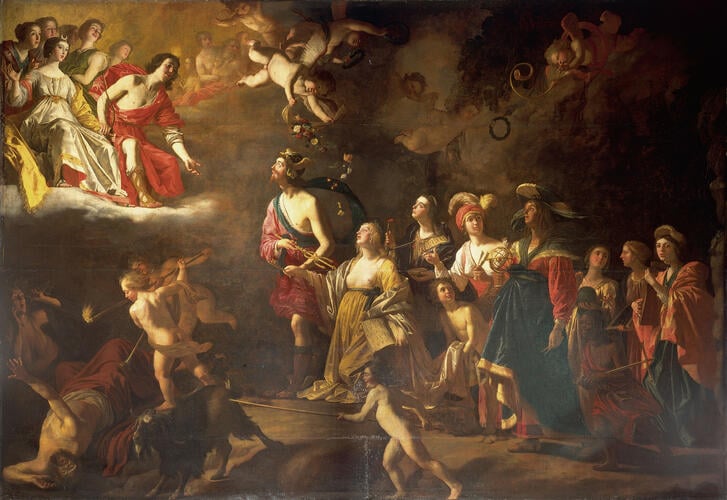-
1 of 253523 objects
Apollo and Diana Signed and dated 1628
Oil on canvas | 357.0 x 640.0 cm (support, canvas/panel/stretcher external) | RCIN 405746

Gerrit van Honthorst (Utrecht 1590-1656)
Apollo and Diana Signed and dated 1628
-
Honthorst was a Dutch painter born and trained in Utrecht. His early career was spent in Rome, where he attained great success as a follower of Caravaggio. In 1620 he returned to Utrecht and largely abandoned religious themes in favour of Arcadian and domestic subjects and portraits. During this period Honthorst received a number of commissions from the exiled Queen Elizabeth of Bohemia, sister of Charles I and through these became known to the English King.
This is one of the most ambitious paintings created by Honthorst during the nine months, April to December 1628, he spent in London working for Charles I. By this date both artist and patron would have known the series of painted panegyrics which Rubens created in 1622-5 for Charles I’s mother-in-law, Marie de Medici, in which modern history and portraiture are combined with mythology and allegory. The Duke of Buckingham visited Paris during their creation and persuaded Rubens to paint for him an allegorical equestrian portrait. It is probably that the Duke of Buckingham, who appears so prominently here, commissioned this work; one can imagine him advising Honthorst to create something along Rubensian lines. The Duke was assassinated in August 1628 during Honthorst’s brief visit, probably while progress on this work was underway.
One of the roles of the enlightened ruler is to encourage learning and the arts: in this image the Duke of Buckingham plays the role of Mercury, messenger and god of commerce, leading the seven Liberal Arts out of a dark cave in which they have been languishing and into the light of royal patronage. He presents them to Charles I (as Apollo, the god of art and learning) and Henrietta Maria (as Diana, Apollo’s sister), who welcome them with gracious courtesy and benign smiles. Apollo is surrounded by nine women probably intended to be the Muses, though without attributes. Winged cherubs distribute the rewards of generous royal (or divine) patronage - bouquets of flowers, laurel crowns - and blow trumpets of Fame.
The Liberal Arts are so called because they are the branches of learning appropriate for a person of liberal (that is free or noble) birth, as opposed to one of low birth, who knows only manual trades. In order of the procession they are: Grammar (possibly a portrait of the Duchess of Buckingham), holding a key (as door-keeper of all other learning) and book; Logic with scales; Rhetoric with a scroll; Astronomy with astrolabe and dividers (and Black attendant holding a cross-staff); Geometry with globe and dividers; Arithmetic with a tablet; and finally Music with a lute. Further attendant children (like cupids but without wings) drive off the enemies of royal cultivation – Envy and possibly Hate – with a torch of Knowledge and a trumpet of Fame. Another prods a goat, possibly symbolising those bestial appetites that keep one from studying.
The painting was first recorded stored near the Banqueting House at Whitehall Palace, but we know nothing of the location for which it was originally intended.
Inscribed: 'GHONTHORST f 1628'Provenance
Recorded in the collection of Charles I, perhaps originally commissioned by the Duke of Buckingham; recorded in the Passage Room Store at Whitehall Palace in 1639 (no 6); sold for £200 to Robert Houghton and others on 23 October 1651 from Hampton Copurt (no 340); recovered at the Restoration and listed in the Hall at Hampton Court in 1666 (no 195)
-
Creator(s)
Acquirer(s)
-
Medium and techniques
Oil on canvas
Measurements
357.0 x 640.0 cm (support, canvas/panel/stretcher external)
Other number(s)